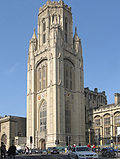University of Bristol
| File:Ubristol-logo.gif | |
| Latin: Bristolliensis (Bris.) | |
| Motto | Vim promovet insitam "[Learning] promotes one's innate power" – from Horace, Ode 4.4[1] |
|---|---|
| Type | Public |
| Established | 1909 (predecessor in 1876)[2] |
| Endowment | £43.2 million[3] |
| Chancellor | Baroness Hale of Richmond[4] |
| Vice-Chancellor | Prof Eric Thomas[5] |
| Visitor | The Lord President of the Council ex officio[6] |
| Students | 23,630[7] |
| Undergraduates | 15,845[7] |
| Postgraduates | 7,785[7] |
| Location | , |
| Campus | Urban |
| Colours | Pantone 187 [8] |
| Affiliations | Russell Group Coimbra Group Worldwide Universities Network |
| Website | http://www.bristol.ac.uk |
The University of Bristol is a university in Bristol, England. It received its Royal Charter in 1909,[10] although its predecessor institution, University College, Bristol, had been in existence since 1876.[11] It is one of the original "red brick" universities.[12] Bristol ranks as one of the top 10 universities in the United Kingdom according to most published league tables.[13][14][15] The University has an annual turnover of £260m and is the largest independent employer in Bristol.[16]
The University is a member of the Russell Group,[17] European-wide Coimbra Group[18] and the Worldwide Universities Network, of which the University's Vice-Chancellor Prof Eric Thomas is the current Chair.[19] The most recent Research Assessment Exercise gave 15 departments a 5* rating.[20] Bristol has around 23,000 students and is one of two universities in Bristol, the other being the more recently established University of the West of England. The University has gained press attention for its high private school intake and the 2003 dispute over its admissions system.[21]
History
|
There shall be from henceforth for ever in Our said City of Bristol a University... |
| King Edward VII, Charter of Incorporation of the University of Bristol, 4 December 1909[22] |

The University was preceded by University College, Bristol, founded in 1876,[11] where its first lecture was attended by only 99 students.[23] The University was able to apply for a Royal Charter due to the financial support of the Wills and Fry families, who made their fortunes in tobacco plantations and chocolate, respectively. Although the Wills Family made vast sums of money from the slave-produced plantations, they later became abolitionists who gave their money to the city of Bristol.[24] The Royal Charter was gained in May 1909, with 288 undergraduates and 400 other students entering the University in October 1909. Henry Overton Wills III became its first chancellor.[11] The University College was the first such institution in the country to admit women on the same basis as men.[11] However, women were forbidden to take examinations in medicine until 1906.[25]
Since the founding of the University itself in 1909, it has grown considerably and is now one of the largest employers in the local area, although it is smaller by student numbers than the nearby University of the West of England.[7] Bristol does not have a campus but is spread over a considerable geographic area. Most of its activities, however, are concentrated in the area of the city centre, referred to as the "University Precinct". It is a member of the Russell Group of research-led UK universities, the Coimbra Group of leading European universities and the Worldwide Universities Network (WUN).
Early years

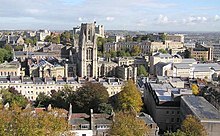
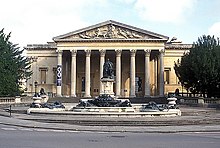

After the founding of the University College in 1876, Government support began in 1889. After mergers with the Bristol Medical School in 1893 and the Merchant Venturers' Technical College in 1909,[26] this funding allowed the opening of a new Medical School and an Engineering School—two subjects that remain among the University's greatest strengths. In 1908, gifts from the Fry and Wills families, particularly £100,000 from Henry Overton Wills III (£6m in today's money), were provided to endow a University for Bristol and the West of England, provided that a Royal Charter could be obtained within two years. In December, 1909, the King granted such a Charter and erected the University of Bristol.[22] Henry Wills became its first Chancellor and Conwy Lloyd Morgan the first Vice-Chancellor.[27] Wills died in 1911 and in tribute his sons George and Harry built the Wills Memorial Building, starting in 1913 and finally finishing in 1925.[28] Today, it houses parts of the academic provision for law, geography and geology, amongst others and graduation ceremonies are held in its Great Hall. The Wills Memorial Building is a Grade II* listed building.[29]
In 1920, George Wills bought the Victoria Rooms and endowed them to the University as a Students' Union.[11] The building now houses the Department of Music and is a Grade II* listed building.[30]
At the point of foundation, the University was required to provide for the local community. This mission was behind the creation of the Department of Extra-Mural Adult Education in 1924 to provide courses to the local community. This mission continues today; a new admissions policy specifically caters to the 'BS' postcode area of Bristol.[31]
Among the famous names associated with Bristol in this early period is Paul Dirac, who graduated in 1921 with a degree in engineering, before obtaining a second degree in mathematics in 1923 from Cambridge. For his subsequent pioneering work on quantum mechanics, he was awarded the 1933 Nobel Prize for Physics.[32] Later in the 1920s, the H.H. Wills Physics Laboratory was opened by Ernest Rutherford.[33] It has since housed several Nobel Prize winners: Cecil Frank Powell (1950);[34] Hans Albrecht Bethe (1967);[35] and Sir Nevill Francis Mott (1977).[36] The Laboratory stands on the same site today, close to the Bristol Grammar School and the city museum.
Sir Winston Churchill became the University's third Chancellor in 1929, serving the University in that capacity until 1965.[11] He succeeded Richard Haldane who had held the office from 1912 following the death of Henry Wills.[27][25]
Mass higher education
During World War II, the Wills Memorial was bombed, destroying the Great Hall and the organ it housed.[11] It has since been restored to its former glory, complete with oak panelled walls and a new organ.
In 1946, the University established the first drama department in the country.[11] In the same year, Bristol began offering special entrance exams and grants to aid the resettlement of servicemen returning home. Student numbers continued to increase, and the Faculty of Engineering eventually needed the new premises that were to become Queen's Building in 1955. This substantial building housed all of the University's engineers until 1996, when Electrical Engineering and Computer Science moved over the road into the new Merchant Venturers' Building to make space for these rapidly expanding fields. Today, Queen's Building caters for most of the teaching needs of the Faculty and provides academic space for the "heavy" engineering subjects (civil, mechanical, and aeronautical).
With unprecedented growth in the 1960s, particularly in undergraduate numbers, the Student's Union eventually acquired larger premises in a new building in the Clifton area of the city, in 1965. This building was more spacious than the Victoria Rooms, which were now given over to the Department of Music. The new Union provides many practice and performance rooms, some specialist rooms, as well as three bars: the Epi; the Mandela (also known as AR2) and the Avon Gorge. Whilst spacious, the Union building is thought by many to be ugly[37] and out of character compared to the architecture of the rest of the Clifton area, having been mentioned in a BBC poll to find the worst architectural eyesores in Britain.[38] The University has proposed relocating the Union to a more central location as part of its development 'masterplan'.[39]
The 1960s were a time of considerable student activism in the United Kingdom, and Bristol was no exception. In 1968, many students marched in support of the Anderson Report, which called for higher student grants. This discontent culminated in an 11-day sit-in at the Senate House (the administrative headquarters of the University).[11] A series of Chancellors and Vice-Chancellors led the University through these decades, with Henry Somerset, 10th Duke of Beaufort taking over from Churchill as Chancellor in 1965 before being succeeded by Dorothy Hodgkin in 1970 who spent the next 18 years in the office.[27]
As the age of mass higher education dawned, Bristol continued to build its student numbers. The various undergraduate residences were repeatedly expanded and, more recently, some postgraduate residences have been constructed. These more recent ventures have been funded (and are run) by external companies in agreement with the University.
Recent history
Since 1988, there have been only two further Chancellors: Sir Jeremy Morse, then chairman of Lloyds Bank who handed over in 2003 to Brenda Hale, the first female Law Lord.[25][27]
One of the few Centres for Deaf Studies in the United Kingdom was established in Bristol in 1981, followed in 1988 by the Norah Fry Centre for research into learning difficulties. Also in 1988, and again in 2004,[40] the Students' Union AGM voted to disaffiliate from the National Union of Students (NUS). On both occasions, however, the subsequent referendum of all students reversed that decision and Bristol remains affiliated to the NUS.
In 2002, the University was involved in argument over press intrusion after details of Euan Blair's application to university (son of then-Prime Minister Tony Blair) were published in national newspapers. Euan eventually gained a 2:1 in Ancient History from Bristol.[41]
As the number of postgraduate students has grown (particularly the numbers pursuing taught Master's Degrees), there eventually became a need for separate representation on University bodies and the Postgraduate Union (PGU) was established in 2000.[42] Universities are increasingly expected to exploit the intellectual property generated by their research activities and, in 2000, Bristol established the Research and Enterprise Division (RED) to further this cause (particularly for technology-based businesses). In 2001, the university signed a 25-year research funding deal with IP2IPO, an intellectual property commercialisation company.[43] In 2007, research activities were expanded further with the opening of the Advanced Composites Centre for Innovation and Science (ACCIS) and The Bristol Institute for Public Affairs (BIPA).
In 2002, the University opened a new Centre for Sports, Exercise and Health in the heart of the University precinct.[44] At a cost, local residents are also able to use the facilities.[45]
Expansion of teaching and research activities continues. In 2004, the Faculty of Engineering completed work on the Bristol Laboratory for Advanced Dynamics Engineering (BLADE). This £18.5m project[46] provides cutting-edge technology to further the study of dynamics and is the most advanced such facility in Europe. It was built as an extension to the Queen's Building and was officially opened by Queen Elizabeth II in March 2005.
In January, 2005, The School of Chemistry was awarded £4.5m by the Higher Education Funding Council for England to create Bristol ChemLabS: a Centre for Excellence in Teaching & Learning (CETL),[47] with an additional £350k announced for the capital part of the project in February, 2006. Bristol ChemLabS stands for Bristol Chemical Laboratory Sciences; it is the only Chemistry CETL in the UK.[48]
There is also a plan to significantly redevelop the centre of the University Precinct in the coming years.[49]
2003 admissions row
The University has been regarded as being elitist by some commentators,[50] taking 42% of its undergraduate students from non-state schools, according to the most recent 2006/2007 figures, despite the fact that such pupils make up just 7% of the population in the UK.[51] It should be noted that 20% of sixth-form pupils attend non-state funded institutions. In late February and early March 2003, Bristol became embroiled in a row about admissions policies, with some private schools threatening a boycott[52] based on their claims that, in an effort to improve equality of access, the University was discriminating against their students. These claims were hotly denied by the University.[53] In August, 2005, following a large-scale survey, the Independent Schools Council publicly acknowledged that there was no evidence of bias against applicants from the schools it represented.[54] The University has a new admissions policy,[31] which lays out in considerable detail the basis on which any greater or lesser weight may be given to particular parts of an applicant's backgrounds—in particular, what account may be taken of which school the applicant hails from. This new policy also encourages greater participation from locally resident applicants.
Academic reputation
League tables generally place Bristol within the top ten universities in the United Kingdom. The 2008 University League Table published by The Times placed Bristol 8th, The Sunday Times placed Bristol 10th and The Good University Guide placed Bristol 7th.[55][56] The Guardian, which uses a slightly different methodology, places Bristol 15th.[57] Internationally, The Times Higher Education Supplement placed Bristol 64th in the world in 2006 and 37th in 2007.[58] Another international ranking, the Shanghai Jiao Tong University Academic Ranking of World Universities, placed Bristol 62nd globally in 2007.[59] According to data published in The Telegraph Bristol has the third-highest percentage of 'good honours' of any UK university, behind Oxford and Cambridge.[60]
Bristol is also known for its research strength, having 15 departments gaining the top grade of 5* in the 2001 Research Assessment Exercise. Overall, 36 out of 46 departments rated gained the top two ratings of 5 or 5*, and 76% of all the academic staff working in departments scored these top two levels.[61][62] In terms of teaching strength, Bristol had an average Teaching Quality Assessment score of 22.05/24 before the TQA was abolished.[63] For admission in October 2005, Bristol reported an average of 10.8 applications per place with the average A-level score on admission being 436.4.[64] That year, Bristol's drop-out rate was 2.2% compared to the benchmark set by HEFCE of no more than 3.1%.[65]
Students' Union and student life
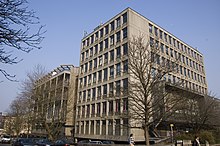
The University has a Students' Union, the University of Bristol Union, which claims to have the largest Students' Union building in the country.[66] From this location, the student radio station BURST (Bristol University Radio Station) broadcasts and the student paper Epigram publishes. In terms of student life, the Union is responsible for the organisation of the annual freshers' fair, the coordination of Bristol Student Community Action, which organizes volunteering projects in the local community, and the organization of entertainment events and student societies. The current President of the union is Tobin Webb.[67] Previous presidents have included Sue Lawley and Liberal Democrat MP Lembit Opik. There is a separate union for postgraduate students, as well as an athletic union, which is a member of the British Universities Sports Association.[68] In distinction to the 'blues' awarded for sporting excellence at Oxford and Cambridge, Bristol's outstanding athletes are awarded 'reds'.[69]
Halls of residence
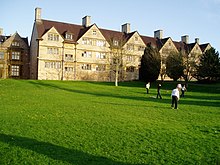
Accommodation for students is primarily in the central precinct of the University and two areas of Bristol: Clifton and Stoke Bishop.[70] In Stoke Bishop, Wills Hall on the edge of the Clifton Downs was the first to be opened, in 1929, by then-Chancellor Winston Churchill. Its original quadrangle layout has been expanded twice, in 1962 and 1990.[70] Churchill Hall, named for the Chancellor, followed in 1956, then Badock Hall in 1964.[70][71] At the time of Badock Hall's establishment, some of the buildings were called Hiatt Baker Hall, but two years later, Hiatt Baker moved to its own site and is now the largest hall in the University.[70][72] The first self-catering hall in Stoke Bishop was University Hall, established in 1971 with expansion in 1992.[70] The Universities newest undergraduate residence, Durdham Hall, was opened in Stoke Bishop in 1994.[70]
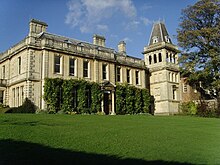
In Clifton, Goldney Hall was built first in the early 1700s by a wealthy merchant family of the same surname and eventually became part of the University in 1956.[73] It is a popular location for filming, with The Chronicles of Narnia, The House of Eliott and Truly, Madly, Deeply, as well as episodes of Only Fools and Horses and Casualty, being filmed there.[74] The Grotto in the grounds is a Grade I listed building.[75] Clifton Hill House is another Grade I listed building now used as student accommodation in Clifton. It was originally built in between 1745 and 1750 by Isaac Ware, and has been used by the University since its earliest days in 1909.[70][76] Manor Hall comprises five separate buildings, the principal of which was erected from 1927–1932 to the design of George Oatley following a donation from Henry Herbert Wills. It has recently been refurbished and officially 'reopened' in 1999.[70][77]

Several of the residences in the central precinct are more recent and have been built and are managed by third-party organisations under exclusivity arrangements with the University. These include Unite House and Chantry Court, opened in 2000 and 2003 respectively by the UNITE Group,[78][79][80] as well as Dean's Court (2001, postgraduates only) and Woodland Court (2005), both run by the Dominion Housing Group.[81][82]
Academic structure
The University is made up of a number of schools and departments organised into six faculties:[83]
Faculty of Arts
|
Faculty of Engineering
Faculty of Medical and Veterinary Sciences
Faculty of Science
|
Faculty of Medicine and Dentistry
Faculty of Social Sciences and Law
|
|
Degrees
Bristol awards a range of academic degrees spanning bachelor's and master's degrees as well as junior doctorates and higher doctorates. The postnominals awarded are the degree abbreviations used commonly among British universities. The University is part of the Engineering Doctorate scheme,[84] and awards the Eng. D. in systems engineering, engineering management, aerospace engineering and non-destructive evaluation.[85]
Bristol notably does not award by title any Bachelor's degrees in music, which is available for study but awarded B.A. (although it does award M.Mus. and D.Mus.), nor any degree in divinity, since divinity is not available for study (students of theology are awarded a B.A.). Similarly, the University does not award B.Litt. (Bachelor of Letters), although it does award both M.Litt. and D.Litt. In regulations, the University does not name M.D. or D.D.S. as higher doctorates, although they are in many universities.[86], as these degrees are normally accredited professional doctorates.
The degrees of D.Litt., D.Sc., D.Eng., LL.D. and D.Mus., whilst having regulations specifying the grounds for award,[87] are most often conferred as honorary degrees (in honoris causa).[88] Those used most commonly are the D.Litt., D.Sc. and LL.D., with the M.A. (and occasionally the M.Litt.) also sometimes conferred honorarily for distinction in the local area or within the University.
Governance
In common with most UK universities, Bristol is headed formally by the Chancellor, currently Brenda Hale and led on a day-to-day basis by the Vice-Chancellor, currently Prof Eric Thomas. There are four Pro-Vice-Chancellors and three ceremonial Pro-Chancellors.[89] The Chancellor may hold office for up to ten years and the Pro-Chancellors for up to three, unless the University Court determines otherwise,[90][91] but the Vice-Chancellor and Pro-Vice-Chancellors have no term limits.[92][93] From September 2008, there will also be a Deputy Vice-Chancellor, who will stand in for the Vice-Chancellor on all matters when the latter is away from the University.[94]
Responsibility for running the University is held at an executive level by the Vice-Chancellor, but the Council is the only body that can recommend changes to the University's statutes and Charter,[95] with the exception of academic ordinances. These can only be made with the consent of the Senate, the chief academic body in the University which also holds responsibility for teaching and learning, examinations and research and enterprise.[95][96] The Chancellor and Pro Chancellors are nominated by Council and appointed formally by Court, whose additional powers are now limited to these appointments and a few others, including some lay members of Council.[97] Finally, Convocation, the body of all staff, ceremonial officers and graduates of the University, returns 100 members to Court and one member to Council,[89] but is otherwise principally a forum for discussion and to ensure graduates stay in touch with the University.
Symbolism
In common with other universities in the United Kingdom, Bristol uses its particular pattern of academic dress as well its logo and coat of arms to represent itself.
Academic dress
The University specifies a mix of Cambridge and Oxford academic dress. For the most part, it uses Cambridge-style hoods and Oxford-style gowns. Unusually for British universities, the hoods are required to be 'University red' (see the logo at the top of the page) rather than black.[98]
Logo and arms
In 2004, the University unveiled its new logo. The icons in the logo are the sun for the Wills family, the dolphin for Colston, the horse for Fry and the ship-and-castle from the mediaeval seal of the City of Bristol, as also used in the coat of arms. The shape of the whole logo represents the open book of learning.[8] This logo has replaced the University Arms shown, but the Arms continue to be used where there is a specific historical or ceremonial requirement. The Arms comprise:
argent on a cross quadrate gules the arms of the City of Bristol between in pale and a sun in splendour (for Wills) and an open book proper, leaved and clasped or, and inscribed with the words Nisi quia Dominus, and in fesse to the dexter a dolphin embowed (for Colston), and to the sinister a horse courant (for Fry), both of the third.
The inscription on the book is the Latin opening of the 124th Psalm, "If the Lord Himself had not (been on our side...)".[1]
Alumni
Bristol has produced 4 Nobel Laureates and academics include 10 Fellows of the Academy of Medical Sciences, 4 Fellows of the British Academy, 12 Fellows of the Royal Academy of Engineering and 18 Fellows of the Royal Society.[99]
Notable alumni of the University of Bristol include writers Dick King-Smith, Angela Carter and David Nicholls, author of the novel Starter for Ten, turned into a screenplay set in the University of Bristol.[100]
Other high-profile former students include illusionist Derren Brown and TV newsreader Alastair Stewart, as well as musician James Blunt. Radio 4 presenter Sue Lawley was a student, as were Little Britain stars Matt Lucas and David Walliams,[101] Simon Pegg (of Hot Fuzz fame) and Chris Morris, creator of the controversial Brass Eye. Liberal Democratic MP Lembit Opik was President of Bristol University Students' Union during his time there. For a full list of famous alumni, see Bristol University's page on notable alumni.
See also
References
- ^ a b "The University Arms". University of Bristol. Retrieved 2007-12-03.
- ^ "NNDB". Bristol University, Educational Institution. Retrieved 2007-05-13.
- ^ "Hefce funding allocations 2007-08: All institutions". The Guardian. Retrieved 2007-12-03.
- ^ "Bristol University". Chancellor’s biography. Retrieved 2007-05-13.
- ^ "Bristol University". Vice Chancellor's welcome. Retrieved 2007-05-13.
- ^ "Institutions for which the President of the Council acts as Visitor". Privy Council Office. Retrieved 2007-12-20.
- ^ a b c d "Table 0a - All students by institution, mode of study, level of study, gender and domicile 2005/06". Higher Education Statistics Agency online statistics. Retrieved 2007-03-31.
- ^ a b "University of Bristol logo". University of Bristol. Retrieved 2007-12-03.
- ^ "University of Bristol Facts & Figures". Retrieved 2007-02-03.
- ^ "The University of Bristol Acts". THE UNIVERSITY OF BRISTOL ACT 1909. Retrieved 2007-05-13.
- ^ a b c d e f g h i "Bristol University History". History of the University. Retrieved 2007-05-13.
- ^ "The University of Bristol". The University of Bristol: About the University. Retrieved 2007-05-14.
- ^ "The Times Good University Guide 2007". Top Universities 2007 League Table. Retrieved 2007-05-14.
- ^ "The Sunday Times University League Table" (PDF). 2007 League Table. Retrieved 2007-05-14.
- ^ "The Good University Guide". The Good University Guide. Retrieved 2007-05-14.
- ^ "Wildscreen Festival 2006: University of Bristol". Wildscreen. 2006. Retrieved 2007-12-20.
- ^ "The Russell Group". List of Russell Group Members. Retrieved 2007-05-14.
- ^ "The Coimbra Group". List of Coimbra Group Members. Retrieved 2007-05-14.
- ^ "The Worldwide Universities Network". List of WUN Group Members. Retrieved 2007-05-14.
- ^ "RAE Assessment Data 2001". 2001 Research Assessment Exercise. Retrieved 2007-05-14.
- ^ "Bristol faces boycott over admissions row". The Guardian. Retrieved 2007-12-03.
- ^ a b "Charter of Incorporation". University of Bristol. Retrieved 2007-12-03.
- ^ "University of Bristol". Guardian. 2007-05-01. Retrieved 2007-12-06.
- ^ "Bristol's slave trading past". Epigram. Retrieved 2007-12-03.
- ^ a b c "Papers of the University of Bristol". Retrieved 2007-12-06.
{{cite web}}: Unknown parameter|publihser=ignored (|publisher=suggested) (help) - ^ "Bristol". Retrieved 2007-12-06.
- ^ a b c d "Bristol University - Former Officers". University of Bristol. Retrieved 2007-06-22.
- ^ "Wills Memorial Building". Retrieved 2007-12-06.
- ^ "University Tower and Wills Memorial Building and attached front walls and lamps". National Monument Record. English Heritage. Retrieved 2007-12-06.
- ^ "Victoria Rooms and attached railings and gates". National Monument Record. English Heritage. Retrieved 2007-12-06.
- ^ a b "Undergraduate admissions principles and procedures (Home/EU students)". Bristol University. Retrieved 2007-12-12.
- ^ "Notable alumni - Faculty of Engineering". University of Bristol. Retrieved 2007-12-06.
- ^ "History of the Department". Department of Physics, University of Bristol. Retrieved 2007-12-06.
- ^ "The Nobel Prize in Physics 1950". The Nobel Foundation. Retrieved 2007-12-06.
- ^ "Hans Bethe - Biography". The Nobel Foundation. Retrieved 2007-12-06.
- ^ "Sir Nevill F. Mott". The Nobel Foundation. Retrieved 2007-12-06.
- ^ "The Students' Union". University of Bristol Union. Retrieved 2007-12-06.
- ^ "What is the worst eyesore in the UK?". BBC News. 2003-11-21.
- ^ "University of Bristol Strategic Masterplan" (PDF). University of Bristol. July 2006. p. 64. Retrieved 2007-12-06.
- ^ "Students' union breaks from NUS". BBC News. 2004-02-05. Retrieved 2007-12-20.
- ^ "Blair's son to go to Bristol University". BBC News. 2002-08-23. Retrieved 2007-12-20.
- ^ "General introduction of the PGU". University of Bristol Postgraduate Union. Retrieved 2007-12-20.
- ^ Donald MacLeod (December 5 2005). "Bristol signs commercial research funding deal". The Guardian. Retrieved 2007-12-03.
{{cite news}}: Check date values in:|date=(help) - ^ "Bristol University - Centre for Sport, Exercise & Health - About us". University of Bristol. 2007-10-02. Retrieved 2007-12-20.
- ^ "Bristol University - Centre for Sport, Exercise & Health - community programmes". University of Bristol. 2007-09-28. Retrieved 2007-12-20.
- ^ "Places - BLADE". University of Bristol. 2007-12-20. Retrieved 2007-12-20.
- ^ "CETL - A £14M Boost for Teaching and Learning in Bristol Chemistry - 27/01/05". University of Bristol. 2007-12-14. Retrieved 2007-12-20.
- ^ "Complete list of funded CETLs". HEFCE. 2007-12-03. Retrieved 2007-12-20.
- ^ Bowden, Chris (2007-09-10). "University of Bristol Masterplan". University of Bristol. Retrieved 2007-12-20.
- ^ "Elite uni aims to broaden its appeal". BBC news. Retrieved 2007-12-12.
- ^ "Understated". Etan Smallman:Epigram Online. Retrieved 2007-12-12.
- ^ "Private schools 'boycott' Bristol". BBC news. Retrieved 2007-12-12.
- ^ "Bristol remains firm on admissions". BBC news. Retrieved 2007-12-12.
- ^ "'No bias' against private pupils". BBC news. Retrieved 2007-12-12.
- ^ "University of Bristol". The Good University Guide Times Online. Retrieved 2007-12-12.
- ^ "League Table Direct: The Good University Guide". The Good University Guide. Retrieved 2007-12-21.
- ^ "University ranking". The Guardian. Retrieved 2007-12-21.
- ^ "Times Higher Education Supplement 2007:The World's Top 200 Universities". The Times Higher Education Supplement. Retrieved 2007-12-21.
- ^ "Top 500 World Universities". Shanghai Jiao Tong University. Retrieved 2007-12-21.
- ^ "University league table". The Telegraph. Retrieved 2007-12-21.
- ^ "2001 Research Assessment Exercise Results" (xls). Higher Education and Research Opportunities. Retrieved 2007-12-21.
- ^ "Bristol: The Good University Guide". The Good University Guide. Retrieved 2007-12-21.
- ^ "HEFCE TQA/QAA SUBJECT REVIEW RESULTS TABLE 1993-present". University of Bristol. Retrieved 2007-12-21.
- ^ "Facts and figures". University of Bristol. Retrieved 2007-12-21.
- ^ "University dropout rate". BBC News. 2007-07-19. Retrieved 2007-12-21.
- ^ "Arrival in Bristol". University of Bristol. Retrieved 2007-12-03.
- ^ Chris Miles (2007-03-12). "Webb finally nets the presidency". Epigram. Retrieved 2007-12-03.
- ^ "BUSA Members". BUSA. Retrieved 2007-12-03.
- ^ "Bristol Reds". University of Bristol. Retrieved 2007-12-03.
- ^ a b c d e f g h "Accommodation Prospectus 2007" (pdf). University of Bristol. p. 3. Retrieved 2007-12-21.
- ^ "Badock Hall Prospectus". University of Bristol. Retrieved 2007-12-21.
- ^ "Hiatt Baker Hall History". University of Bristol. Retrieved 2007-12-21.
- ^ "Goldney Hall History". University of Bristol. Retrieved 2007-12-21.
- ^ "Titles with locations including Goldney Hall, Clifton, Bristol, England, UK". Internet Movie Database. Retrieved 2007-01-03.
- ^ "Grotto approximately 85 metres south of Goldney House, Clifton Hill, Bristol". National Monument Record. English Heritage. Retrieved 2007-12-21.
- ^ "Clifton Hill House and attached front walls, Clifton Hill, Bristol". National Monument Record. English Heritage. Retrieved 2007-12-21.
- ^ "Manor Hall and Sinclair House History". University of Bristol. Retrieved 2007-12-21.
- ^ "UNITE House in Bristol". UNITE Group plc. Retrieved 2007-12-21.
- ^ "Chantry Court". University of Bristol. Retrieved 2007-12-21.
- ^ "Chantry Court in Bristol". UNITE Group plc. Retrieved 2007-12-21.
- ^ "Dean's Court". University of Bristol. Retrieved 2007-12-21.
- ^ "Woodland Court". University of Bristol. Retrieved 2007-12-21.
- ^ "Academic Departments and Research Centres by Faculty". University of Bristol. Retrieved 2007-08-10.
- ^ "Engineering Doctorate Centre Details". Engineering and Physical Sciences Research Council. Retrieved 2006-07-18.
- ^ "Regulations for the Degree of Engineering Doctorate (Eng. D.)". University of Bristol. Retrieved 2007-08-06.
- ^ "Regulations for Dissertations for Doctoral and Masters Degrees..." University of Bristol. Retrieved 2007-08-06.
- ^ "Regulations for the Degrees of Doctor of Letters, Doctor of Science, Doctor of Engineering and Doctor of Laws". University of Bristol. Retrieved 2007-08-06.
- ^ "Honorary Graduates". University of Bristol. Retrieved 2007-08-06.
- ^ a b "Governance: How the University is run". University of Bristol. Retrieved 2007-12-21.
- ^ "Statute 3 — The Chancellor". University of Bristol. 2000-03-15. Retrieved 2007-12-21.
- ^ "Statute 4 — The Pro-Chancellors". University of Bristol. Retrieved 2007-12-21.
- ^ "Statute 5 — The Vice-Chancellor". University of Bristol. 2000-03-15. Retrieved 2007-12-21.
- ^ "Statute 6 — The Pro Vice-Chancellors". University of Bristol. 2004-02-24. Retrieved 2007-12-21.
- ^ "University gets new deputy chief" (Press release). University of Bristol. 2007-12-04. Retrieved 2007-12-21.
- ^ a b "Council". University of Bristol. Retrieved 2007-12-21.
- ^ "Senate". University of Bristol. Retrieved 2007-12-21.
- ^ "Statute 13 — Powers of Court". University of Bristol. 2005-05-07. Retrieved 2007-12-21.
- ^ "Regulations for Academic and Official Costume". University of Bristol Regulations for Academic and Official Costume. Retrieved 2007-12-21.
- ^ "Nobel Prizes and Fellowships". University of Bristol. Retrieved 2007-12-03.
- ^ "Starter for Ten". BBC Bristol. Retrieved 2007-12-21.
- ^ "Notable alumni". Bristol University. Retrieved 2007-12-21.
Further reading
- University for Bristol: A History in Text and Pictures by Don Carleton, University of Bristol P. (October 1984), ISBN-10: 0862922003
- Wills Memorial Building (University of Bristol Buildings series) by Sarah Whittingham, ISBN-10: 086292541X
- How Did This Garden Grow?: The History of the Botanic Gardens of the University of Bristol by Rosalind Delany, Friends of Bristol University Botanic Garden ISBN-10: 0954350405
External links
|
University and Media |
Newspaper Profiles
|

